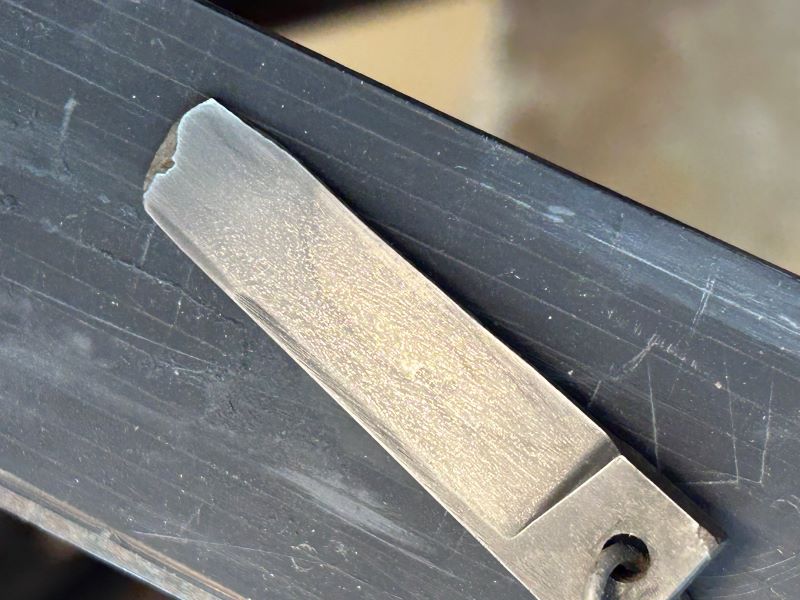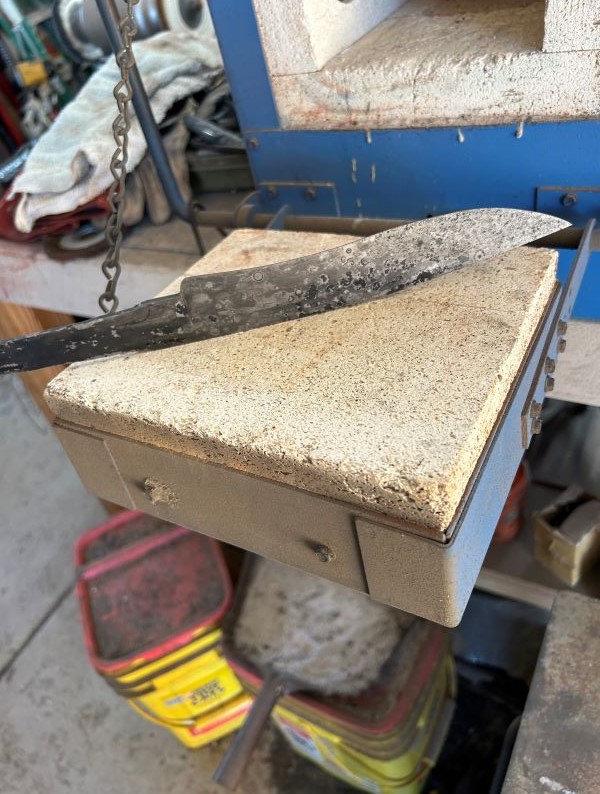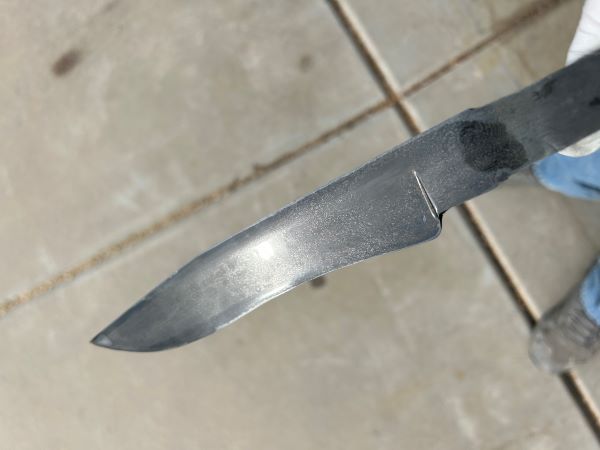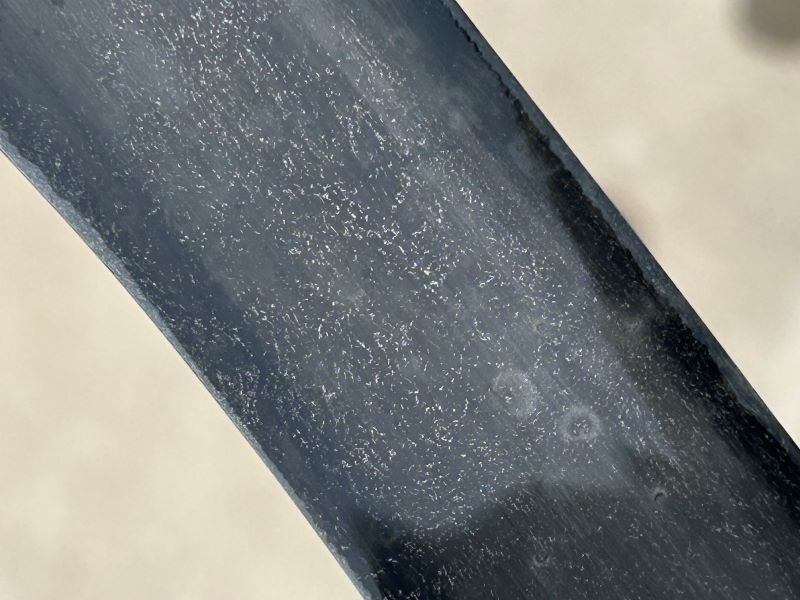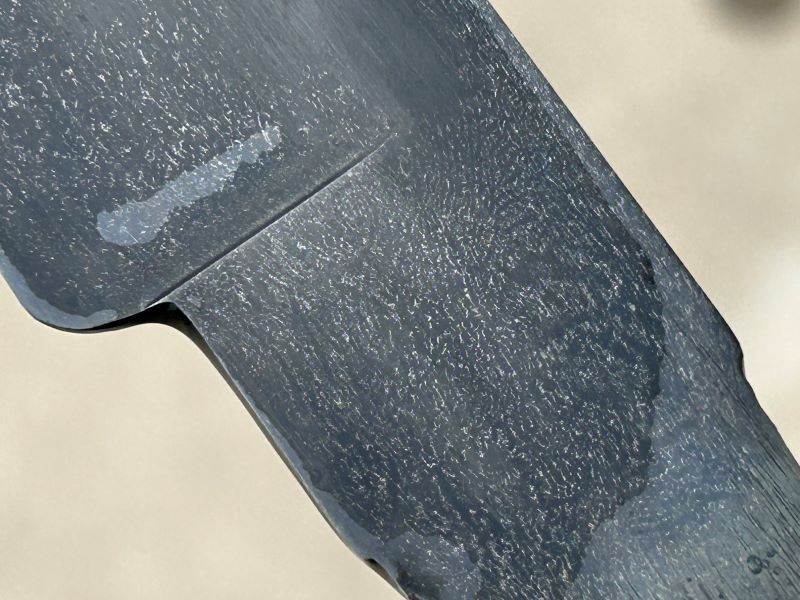Quote from Joshua States on June 9, 2024, 8:26 pmI'm not really sure what happened with this one from last year. The bar forged out fairly well (i only lost a small piece of it and the coupon I cut off and finished out etched okay (pic 1). The blade went through HT without a hitch (pic 2) and I thought it had promise. But in the end, the patterning was less than desirerable. (pics 3, 4, & 5)
I'm not really sure what happened with this one from last year. The bar forged out fairly well (i only lost a small piece of it and the coupon I cut off and finished out etched okay (pic 1). The blade went through HT without a hitch (pic 2) and I thought it had promise. But in the end, the patterning was less than desirerable. (pics 3, 4, & 5)
Uploaded files:Quote from Jacob Christian on June 12, 2024, 7:12 am@joshua-states This looks like a higher Mn content and somewhat low Carbon. It is hard to tell because there could be many different factors at play here.
What did you etch in? Have you tried other etchants?
FeCl tends to make the background really dark and wash out some of the cementite. To combat this I use FeCl and then finish it with oxalic acid. Oxalic acid can be found as wood bleach at most hardware stores. If you would like more information on how to prepare Oxalic, I can put that on here.
Also if you melted your ingot in an open crucible, it is quite likely that your carbon content is lower than what you calculated.
@joshua-states This looks like a higher Mn content and somewhat low Carbon. It is hard to tell because there could be many different factors at play here.
What did you etch in? Have you tried other etchants?
FeCl tends to make the background really dark and wash out some of the cementite. To combat this I use FeCl and then finish it with oxalic acid. Oxalic acid can be found as wood bleach at most hardware stores. If you would like more information on how to prepare Oxalic, I can put that on here.
Also if you melted your ingot in an open crucible, it is quite likely that your carbon content is lower than what you calculated.
Quote from Joshua States on June 12, 2024, 7:25 pmThe formula was pretty loose on this one as I was using some titaniferous magnetite as a CFE donor. So the Mn content is possible. I thought the patterning in the coupon was OK, not great, and I expected similar results from the rest of the bar.
I etch in 6% nitric. I'll take a recipe for oxalic acid. More info is always a good thing.
I thought the C content was pretty high based on the spark test. https://drive.google.com/file/d/1Lo8TL634-yMt1TLjEJ0j51YsmytgZBwq/view?usp=sharing
The formula was pretty loose on this one as I was using some titaniferous magnetite as a CFE donor. So the Mn content is possible. I thought the patterning in the coupon was OK, not great, and I expected similar results from the rest of the bar.
I etch in 6% nitric. I'll take a recipe for oxalic acid. More info is always a good thing.
I thought the C content was pretty high based on the spark test. https://drive.google.com/file/d/1Lo8TL634-yMt1TLjEJ0j51YsmytgZBwq/view?usp=sharing
Quote from Jacob Christian on June 18, 2024, 11:12 amFor the oxalic acid, combine distilled water and powdered oxalic acid until the saturation point (No more acid is absorbed into the water and crystals remain on the bottom). Next add a bit of dish soap (Reduce surface tension of the water) and some isopropyl alcohol. I do not have exact measurements because I do not believe it is necessary. Just measure with your heart lol. After all of this is done, add steel wool to the solution. If all of it dissolves, add some more and keep doing this until no more is dissolved. This creates an Fe2/Fe3 solution that will deposit oxides on the surface of your piece. Quite similar to nugui if you are familiar with Japanese sword polishing.
Quote from Joshua States on June 12, 2024, 7:25 pmThe formula was pretty loose on this one as I was using some titaniferous magnetite as a CFE donor. So the Mn content is possible. I thought the patterning in the coupon was OK, not great, and I expected similar results from the rest of the bar.
I etch in 6% nitric. I'll take a recipe for oxalic acid. More info is always a good thing.
I thought the C content was pretty high based on the spark test. https://drive.google.com/file/d/1Lo8TL634-yMt1TLjEJ0j51YsmytgZBwq/view?usp=sharing
6% nitric should definitely reveal any microstructures in the steel and the spark test does look pretty good.... So if the the pattern looks pretty good with only a quick dip in nitric, that would point to Mn. The oxalic should help with that.
For the oxalic acid, combine distilled water and powdered oxalic acid until the saturation point (No more acid is absorbed into the water and crystals remain on the bottom). Next add a bit of dish soap (Reduce surface tension of the water) and some isopropyl alcohol. I do not have exact measurements because I do not believe it is necessary. Just measure with your heart lol. After all of this is done, add steel wool to the solution. If all of it dissolves, add some more and keep doing this until no more is dissolved. This creates an Fe2/Fe3 solution that will deposit oxides on the surface of your piece. Quite similar to nugui if you are familiar with Japanese sword polishing.
Quote from Joshua States on June 12, 2024, 7:25 pmThe formula was pretty loose on this one as I was using some titaniferous magnetite as a CFE donor. So the Mn content is possible. I thought the patterning in the coupon was OK, not great, and I expected similar results from the rest of the bar.
I etch in 6% nitric. I'll take a recipe for oxalic acid. More info is always a good thing.
I thought the C content was pretty high based on the spark test. https://drive.google.com/file/d/1Lo8TL634-yMt1TLjEJ0j51YsmytgZBwq/view?usp=sharing
6% nitric should definitely reveal any microstructures in the steel and the spark test does look pretty good.... So if the the pattern looks pretty good with only a quick dip in nitric, that would point to Mn. The oxalic should help with that.
